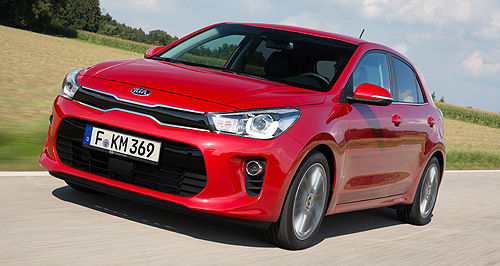Future models - Kia - RioParis show: Three-pot power for Kia RioRio podium: Kia’s all-new Rio will take to the stage at the Paris motor show late this month, revealing its new look and selection of segment-first features. Kia outlines all-new Rio range in Paris ahead of 2017 arrival Down Under16 Sep 2016 KIA has detailed global specification for its larger, safer and more efficient next-generation Rio compact hatchback, but confirmation of the Australian variant spread will have to wait until the model’s official unveiling in Paris later this month. The South Korean car-maker’s little hatch will be offered in various worldwide markets as either a three or five door, but only the latter will be launched in Australia. Beyond that, all other details including which of the six engines, three transmissions and trim options will come here remains speculative. Kia Australia is unable to confirm the arrival date for the new Rio Down Under, but given the company’s history and ongoing commitment to support the Australian Open tennis tournament, it is likely the little hatch will break cover on Melbourne’s blue courts in late January. For the new Rio, Kia has dropped the 1.6-litre petrol engine, but introduced two versions of a new turbocharged 1.0-litre T-GDI three cylinder producing 73kW and 88kW and a torque output of 172Nm in both cases. Many rival manufacturers are adopting three-pot power in the name of efficiency and space conservation including Ford, which offers a more premium three-cylinder Fiesta, While Peugeot and Citroen’s triple is offered at the entry level. With no clear power advantage over the other 1.4-litre option, it is unclear if the variant will be positioned at the affordable end of the Rio line-up or the upper end, if the car-maker confirms the smallest donk for the local range. Other possibilities in the powertrain catalogue include a 1.2-litre four-cylinder petrol with 62kW and 122Nm, a 1.4-litre petrol producing 88kW and 132Nm or a pair of 1.4-litre diesels with 52kW and 66kW respectively. The higher power diesel develops 240Nm. CO2 emissions have fallen with the naturally aspirated engines expected to produce fewer than 120g per km, the turbo petrol is forecast to do better than 100g/km, while the Kia engineers have designed the diesels to come in under 90g/km. All engines comply to Euro 6b standards. Only the 1.4-litre is offered with an automatic transmission or six-speed manual making it the most likely candidate for sale in Australia’s auto-centric market. 1.0-litres are available with either five or six-speed manual, diesels are only paired with the six-speed manual, while the 1.2-litre is five-speed manual only. In addition to the Rio’s new look and small increase in overall exterior dimensions, Kia has boosted interior space. Legroom is up to 1120mm in the front and 770mm in the second row, while headroom is up to 1021mm and 966mm respectively. Boot space is up 37 litres to a luggage-swallowing 325 litres and includes a split level floor for owners to tailor the load area for different items or to hide them out of sight in a separate compartment. A mobility kit maximises boot volume but customers can specify a spare wheel if required. Extra storage has also been designed into the new Rio with a double open storage tray at the base of the centre console, overhead storage for smaller items such as sunglasses, while each door can accommodate a bottle – 1.5-litre in the front and 0.5-litres in the back. Kia says its new Rio is one of the safest options in its class with a five-star Euro NCAP rating in its sights and a host of new passive and active systems including autonomous emergency braking with pedestrian recognition – the first car in the B-segment with the technology it says. The technology is complemented by a new lane departure warning system, which warns the driver if the vehicle strays into another lane without indication. More high-strength steel has been used in the Rio construction and is part of the company’s strategy to reduce average vehicle weight by five per cent by 2020. Every Rio has six airbags and Isofix child seat anchors. The car-maker is also reporting an improved ride and driving enjoyment thanks to a revised chassis recipe of MacPherson front struts and rear torsion beam suspension. The stiffer and lighter shell allowed for a more compliant chassis tune without compromising dynamics or handling. Steel 15-inch wheels are standard but can be upgraded to alloy versions in the same diameter or larger 16- and 17-inch sizes. Infotainment systems have also stepped up to the latest Android Auto and Apple CarPlay supporting system, accessible through the standard “floating” 5.0-inch touchscreen but customers can upgrade to a 7.0-inch version, which adds navigation. In Europe, Kia Connected Services will include seven years of up-to-date information access included in the price of the Rio, allowing access to traffic updates, speed camera locations and weather information. Second row occupants will not be excluded from the technological updates with a USB connection for rear passengers as well a separate socket in the front of the car – another first for the compact segment says Kia.  Read more1st of September 2016  Paris show: Kia’s Rio grows upFourth-generation Kia Rio fills out on all-new platform with longer wheelbaseRio pricingMotor industry news |
Click to shareKia modelsResearch Kia Rio pricingMotor industry news |
































Facebook Twitter Instagram